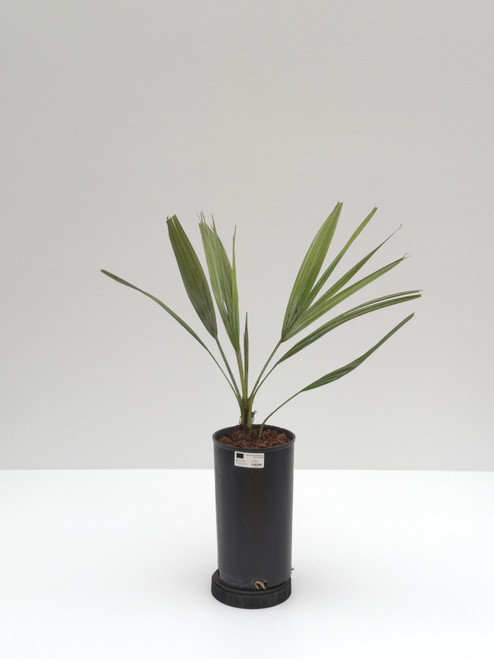Product Description
Habitat and Distribution
Brahea moorei is found in Mexico, Northeast. Sierra Madre Oriental, in north-eastern Mexico. Dry, high altitude oak forest on rocky limestone slopes, between 1500, and 2000 m.
Description
This Brahea is so unique that it cannot be confused with any other Brahea. Beautiful soft leaf ideal for small gardens. Non trunked to creeping habit and genetically dwarf. First true leaves appear at about age three to four years old and are about 6 to 9 inches wide. Ten year old trees have leaves that are about 3 feet wide and full spread of trees are about 5 feet wide. It takes about ten years for this tree to fully mature and produce the waxy coating on the flower stock and new emerging leaves. The waxy coating that is also on the new leaf as the new leaf opens, remains on the tips of the leaf ridges as well as the underside of the leaf. Goats in habitat limit the production of seeds since the flower stocks are eaten and limit natural propagation. Flower stocks are three times as long as the smooth petioles. Trees in fruit exhibit stalks upright above the tree topped with clusters of yellow fruit. Germination rate is excellent although it may take as long as a year. Seeds are not produced during periods of drought. (Palm Society, Northern California)
Habit: Solitary and acaulescent, often caespitose; crown holds 5-7 leaves, Leaf Size: 2’ wide, Foliage: Mature plant; Dark green with white appearing both on top in between leaflets and, more completely, on the bottom of the leaf., greyish to silvery blue underneath, Flower Color: White, The inflorescence is erect, and stands above the foliage, Fruit Color: Purple.
Culture
Growth Rate: Slow, Height: 2-4’, Salt Tolerance: Low, Soil Preference: Alkaline, Drought Tolerance: High, Light Requirements: High Hazards: None reported, Pest Problems: Palmetto weevils, Disease Problems: Phytophthora root and bud rot. USDA Hardiness Zone: 8a; No damage at 14°F.
Comments and Curiosities
"Rare in cultivation, this is basically a trunkless palm. Has large blue-green fan leaves that are nearly circular and have a chalky white on the underside. Very cold hardy for a Brahea, but doesnt like it too wet. Has spineless petioles (think only the only other Brahea that has spineless petioles is B. nitida). Probably the smallest, or second smallest species of the genus." (Geoff Stein)
The smallest of the Braheas is immediately recognizable by its short habit, the absence of a trunk (which actually is underground), the lush, dark green leaves with stunning white undersides, and the long inflorescences that extend well beyond them. Brahea moorei is native to the dry, high altitude oak forest in the Sierra Madre Oriental in northeastern Mexico between 1400 and 2000 m (4600 to 6600 ft.). In cultivation, it is suitable for temperate and subtropical climates and can handle severe frosts down to about -10°C (14°F) without damage. Due to its small size, the Dwarf Rock Palm is an ideal, tough and very attractive ground cover for shade or sun. (RPS.com)































